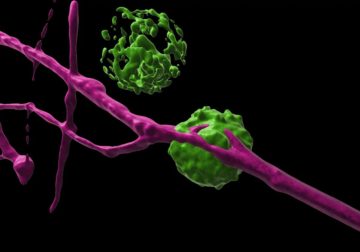Rachael Gorman in The Scientist:
 Skin shields our bodies from the world’s dangers, but sometimes, with a nick or a bump, that barrier is breached. That’s when pain- and itch-sensing nociceptor neurons jump to action, transmitting threat signals to the central nervous system, while dendritic cells eliminate pathogens by secreting cytokines and coordinating local inflammation, while also playing a role in adaptive immunity.
Skin shields our bodies from the world’s dangers, but sometimes, with a nick or a bump, that barrier is breached. That’s when pain- and itch-sensing nociceptor neurons jump to action, transmitting threat signals to the central nervous system, while dendritic cells eliminate pathogens by secreting cytokines and coordinating local inflammation, while also playing a role in adaptive immunity.
But this work is not done in isolation: Dendritic cells (DCs) and nociceptors are entangled in a powerful partnership, and a new study published March 31 in Science describes three unique ways these intertwined cells communicate to fine-tune the fight against invaders.
Back in the early 2010s, clinicians observed that people with the autoimmune inflammatory skin condition psoriasis who also happen to have nerve damage don’t suffer from the condition’s hallmark skin lesions in the injured area. When the nerve heals, however, the lesions return. Lorena Riol-Blanco and Ulrich von Andrian, immunology researchers at Harvard University, were intrigued, and in 2014, their team discovered for the first time that DCs interact with nociceptors. They found that this relationship is necessary for an inflammatory response: DCs sit on nociceptor axons and require a signal from them to make the cytokine interleukin (IL)-23, which is the master driver of psoriasis skin inflammation. The precise nature of this relationship, however, eluded them. “We didn’t know what’s the language that’s being spoken there,” von Andrian tells The Scientist. Answering “the question ’How exactly does it actually work?’ was a five-year process.”
More here.
